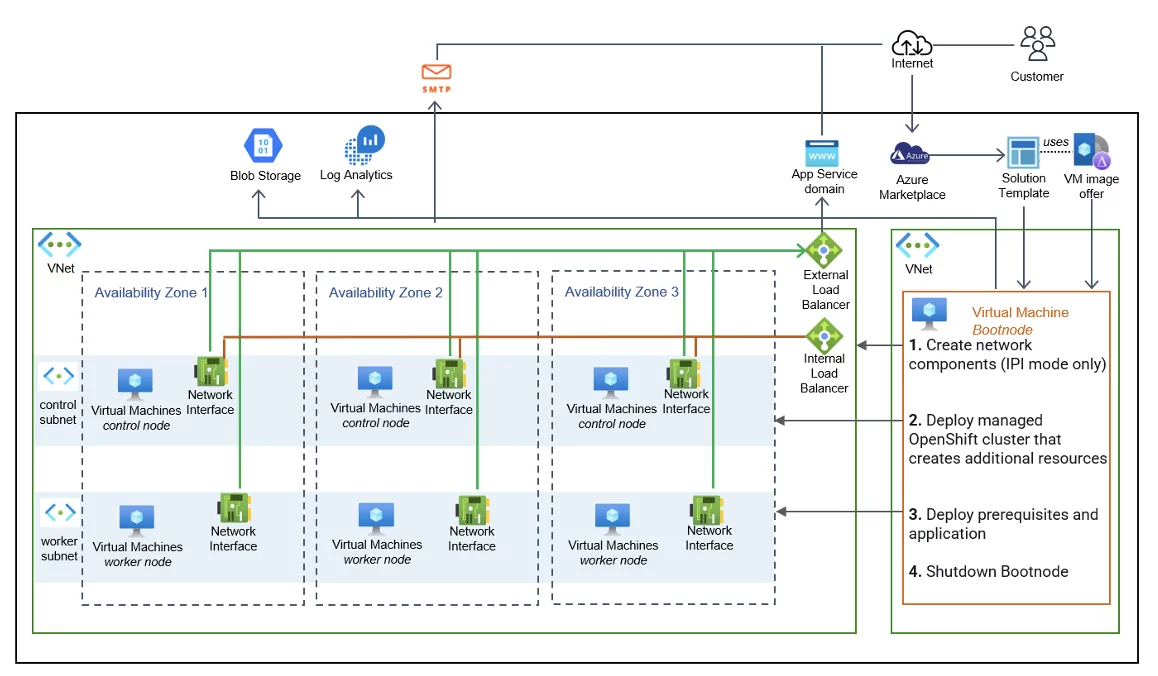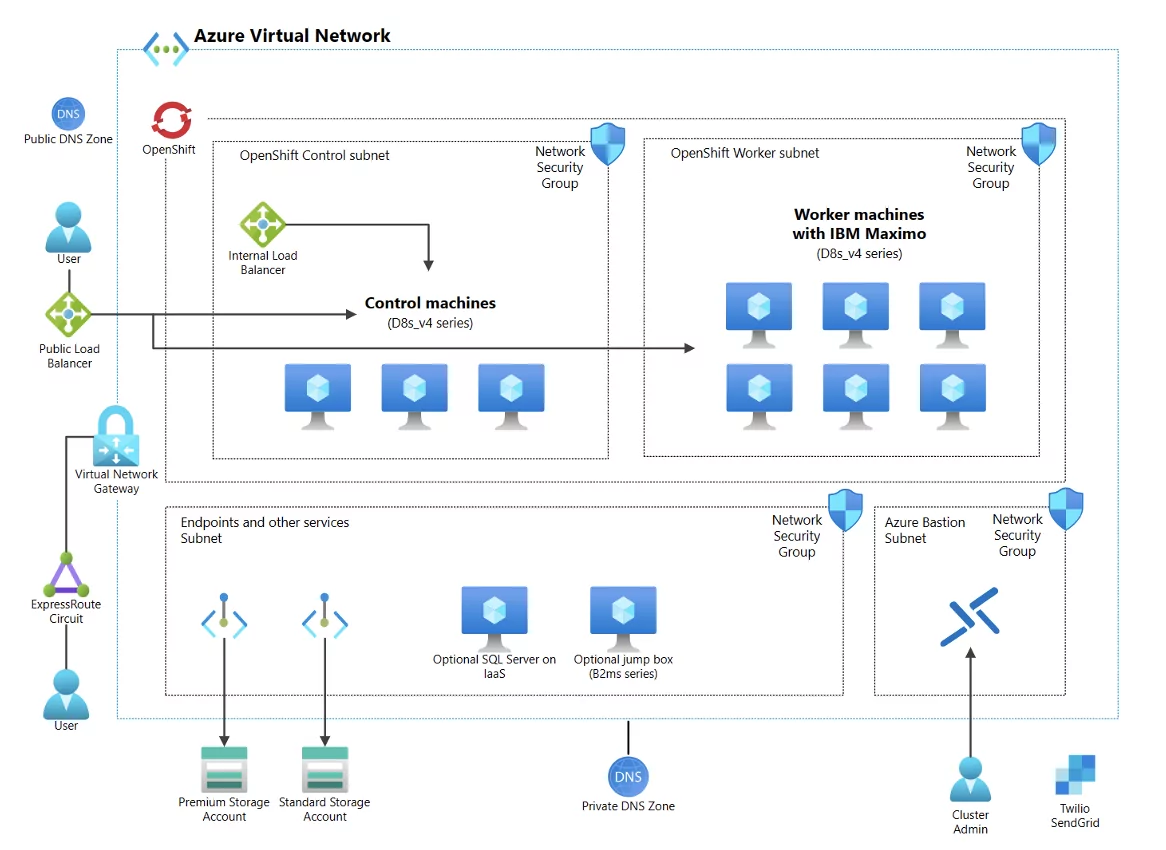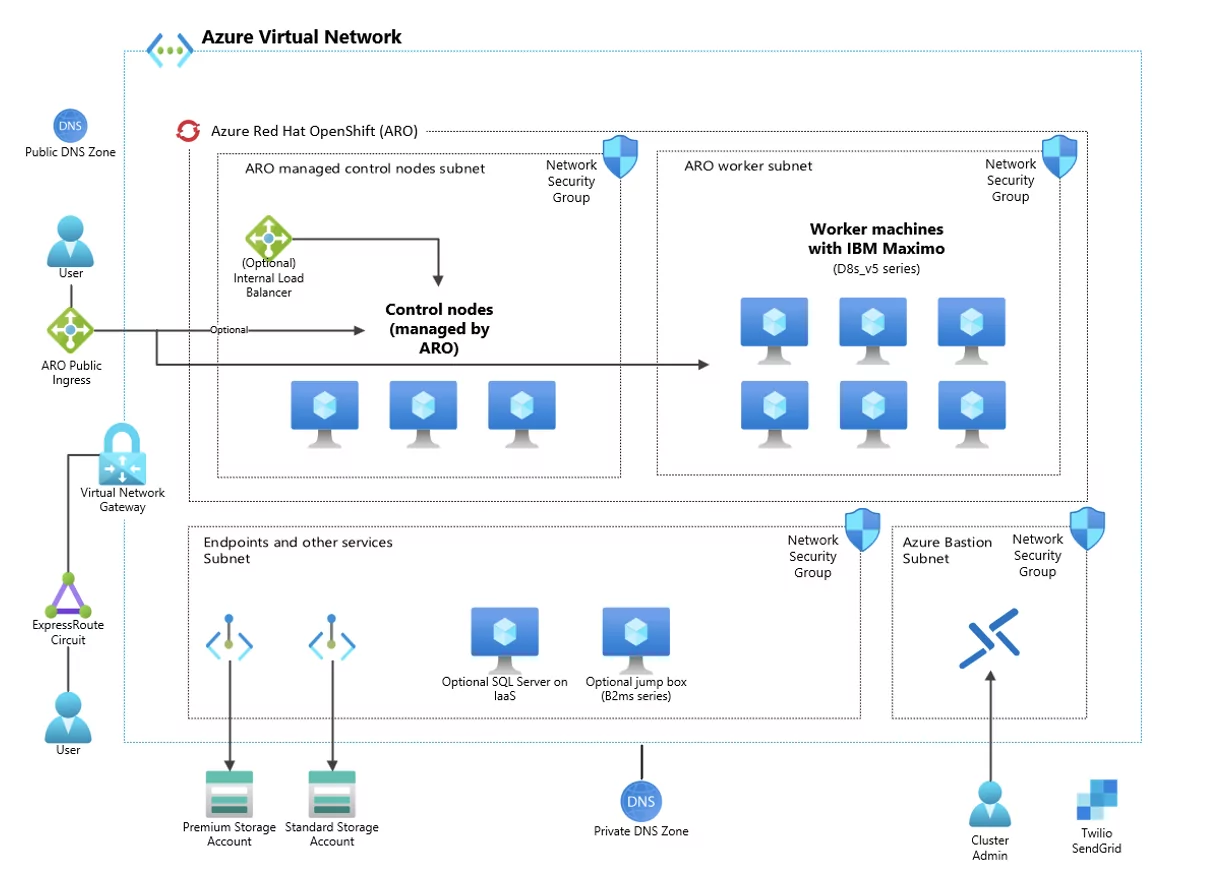
IBM® Maximo® has been a leading enterprise asset management solution in the industry for four decades, helping customers streamline work processes with a centralized platform for managing tasks, inventory, regulatory compliance and reporting capabilities. IBM Maximo Application Suite (MAS), the next generation of IBM Maximo, delivers a better user experience, faster integration, robust AI analytics, and a broad range of cloud deployment options. MAS provides organizations with a robust and modern asset management solution.
Red Hat® OpenShift®, the industry’s leading hybrid cloud application platform powered by Kubernetes, brings together tested and trusted services to reduce the friction of developing, modernizing, deploying, running and managing applications. OpenShift delivers a consistent experience across public cloud, on premises, hybrid cloud or edge architecture.
Azure is Microsoft’s public cloud platform. Azure offers a large collection of services, which includes platform as a service (PaaS), infrastructure as a service (IaaS) and managed database service capabilities.
Microsoft Azure Red Hat® OpenShift® (ARO) provides highly available, fully managed OpenShift clusters on demand, monitored and operated jointly by Microsoft and Red Hat. OpenShift brings added-value features to complement Kubernetes, making it a turnkey container PaaS with a significantly improved developer and operator experience.
Maximo customers will be required to move to MAS when Maximo 7.x reaches end of life. MAS has been containerized to run specifically on Red Hat OpenShift. To ease this transition for customers who are unfamiliar with running containers in production, IBM, Microsoft and Red Hat have teamed up to provide a validated architecture for running MAS on Azure Red Hat OpenShift.
This blog will walk through the recommended options for running MAS on Azure and describe how the IBM, Red Hat and Microsoft Azure components come together and provide a solid foundation for running MAS. We will also explore the architectural decisions to consider, so you can choose the one that best fits your organization’s needs.
For each option below, there are two components to keep in mind: the MAS application and the platform MAS runs on (Red Hat OpenShift or Microsoft Azure Red Hat OpenShift).
Option 1 provides a scripted install process for the MAS application and the underlying OpenShift Container Platform (OCP). This process makes the overall installation process simpler. However, the ability to customize the MAS installation is limited since it is script-based. Additionally, because the underlying platform is a self-managed OCP, the customer has complete control over the infrastructure in exchange for monitoring and maintaining that OCP cluster.
Option 2a requires the customer to install MAS themselves but allows for greater customization of MAS during the installation process. This option also provides complete control over the underlying OCP but requires the customer to install, monitor and maintain OCP.
Option 2b requires the customer to install MAS themselves but allows for greater customization of MAS during the installation process. In this option, the underlying platform is Microsoft ARO, a managed version of OCP offered by Microsoft. The installation of ARO is scripted, and Red Hat site reliability engineers (SREs) are responsible for monitoring and maintaining the OCP cluster. However, because Red Hat SREs manage the cluster, customers will have less control over the platform infrastructure than in options 1 and 2a.
| Installation option | MAS installation | MAS installation customization | Platform creation | Platform control | Platform (OCP) management |
| Option 1 | Scripted | Less customization | Scripted | Complete control | Customer managed |
| Option 2a | Manual by customer | More customization | Customer driven | Complete control | Customer managed |
| Option 2b | Manual by customer | More customization | Scripted | Less control | Red Hat SRE managed |
Scroll to view full table
Option 1: MAS on self-managed Red Hat OpenShift through Marketplace
This deployment option involves setting up MAS on an OpenShift cluster, which runs on the Azure platform. Azure Marketplace serves as the conduit through which this deployment is made possible.
One of the primary advantages of choosing this deployment option is the ease of deployment. Azure Marketplace simplifies the process by providing pre-configured templates and scripts that are deployed on the customer’s behalf. One can use this pattern to set up MAS quickly and efficiently, reducing software deployment complexity.
You can deploy a new cluster, use an existing one or deploy a new one into an existing network. However, you must provide the expected database and email configurations before the deployment. This flexibility enables organizations to optimize their infrastructure and adapt to changing needs. The Azure Marketplace pattern simplifies the deployment process, allowing businesses to focus on using MAS to enhance their asset management practices quickly.
It’s essential to carefully consider resource allocation, data security, integration and support to enable a successful deployment and maximize the benefits of MAS. With the right planning and execution, organizations can unlock the full potential of MAS in their asset management journey through Azure Marketplace with minimal effort.

Option 2a: MAS on self-managed Red Hat OpenShift through “do it yourself” option
Deploying MAS on a self-installed OpenShift cluster on Microsoft Azure through the “do it yourself” option means you have complete control over the installation process. Unlike other deployment methods, where the environment is pre-configured, this approach empowers you to customize your MAS deployment to align with your specific requirements.
One of the primary advantages of choosing the “do it yourself” option is its unparalleled level of control. You can tailor the deployment to your unique needs, ensuring every component is configured to optimize the asset management processes.
With this option, you can select your preferred installer from various options, including installer provisioned infrastructure, user provisioned infrastructure and even an airgap configuration. This flexibility allows you to use your existing expertise or choose the installer that aligns best with your infrastructure and security requirements.
However, it’s essential to recognize this option’s need for skilled resources, the potential complexity of the deployment process and the ongoing support and maintenance responsibilities. With the right expertise and a well-thought-out plan, the “do it yourself” option can be a powerful choice for organizations looking to maximize the potential of MAS in their asset management journey.

Option 2b: MAS deployment on Azure Red Hat OpenShift managed by Microsoft Azure
MAS is deployed on ARO in this option. This strategic combination offers a range of advantages for businesses looking to streamline their processes. This option provides a middle ground between the previous two options.
MAS on ARO is straightforward to set up and will require less effort than the “do it yourself” approach while giving you similar levels of control over OpenShift and MAS. It is mainly for those who prefer not to manage OpenShift themselves, but who still want control over the hosting platform. However, as you’ll be interfacing with OpenShift directly, you will still need team members skilled in OpenShift to make this option work. While this option requires less work from an ongoing management perspective, as OpenShift management is taken care of, it will take additional upfront work because you will be deploying MAS by yourself.
The advantages of MAS deployment on ARO are multifaceted. First, it lowers the entry barrier and requires a smaller OpenShift/Kubernetes resources skill set on day one to get started. Most importantly, you no longer need to spend time and effort setting up OpenShift and applying subsequent updates.
Second, it provides a managed experience through a PaaS offering supported by Microsoft and RedHat. It provides distinct benefits for those prioritizing rapid access to support services. It simplifies the overall experience of managing the health and updates of OpenShift, as Microsoft is responsible for that.
Each MAS on Azure deployment option has its advantages and limitations. You should review these factors to align their deployment with your business needs and requirements.
You should assess their infrastructure, customization and cost considerations to make an informed decision that ensures a successful and efficient MAS deployment. By understanding the strengths and limitations of each option, customers can choose the deployment option that meets their business objectives.

Engage with IBM today
More from Sustainability

November 16, 2023
Creating a sustainable future with the experts of today and tomorrow
4 min read – When extreme weather strikes, it hits vulnerable populations the hardest. In the current global climate of stronger and more frequent storms, heat waves, droughts and floods, how do we build more positive environmental and social impact? We have a responsibility to apply our technological expertise, resources and ecosystem to help the world become more resilient to these environmental challenges. We need a three-pronged approach to long-term sustainability: preparing the workforce with skills for a greener future; forging strategic cross-sector partnerships;…

November 9, 2023
Transforming small farming with open-source, AI-powered connected edge solutions
3 min read – Smallholder farmers, often owning five hectares of land or less, play a critical role in global food security—with approximately 570 million of them producing up to one-third of the food consumed worldwide. However, they face numerous challenges, including limited access to modern technology and the increasing impacts of climate change. Edge computing is helping to revolutionize agriculture, and the Linux Foundation is at the forefront of this transformation. The foundation developed Liquid Prep, an intelligent mobile app-based watering solution, as…

November 8, 2023
17 IBM products win TrustRadius 2023 Best of Awards
2 min read – Thanks to favorable client reviews, 17 IBM offerings have secured a placement on the TrustRadius Best of Awards list. These awards help direct buyers who are doing research on new products and solutions for their business needs. According to the annual Buying Disconnect Report produced by TrustRadius—“The Self-Serve Economy is Prove It or Lose It”—the top five resources buyers use are product demos, user reviews, prior experience, free trials and vendor websites. The takeaway—buyers want to self-service their way through their…

November 8, 2023
FDA FSMA: Providing value beyond compliance
5 min read – The supply chain plays a pivotal role in delivering goods and services to both businesses and consumers, serving as the connective thread between industries, nations, communities and all components of the value chain. Our dependence on supply chains is most pronounced in ensuring food supply. However, over the decades, the supply chain has grown longer and increasingly intricate, which means consumers may find themselves more distant from the origin of the products they consume. Supply chains comprise multiple tiers and…
IBM Newsletters
Get our newsletters and topic updates that deliver the latest thought leadership and insights on emerging trends.
Subscribe now More newsletters
- SEO Powered Content & PR Distribution. Get Amplified Today.
- PlatoData.Network Vertical Generative Ai. Empower Yourself. Access Here.
- PlatoAiStream. Web3 Intelligence. Knowledge Amplified. Access Here.
- PlatoESG. Carbon, CleanTech, Energy, Environment, Solar, Waste Management. Access Here.
- PlatoHealth. Biotech and Clinical Trials Intelligence. Access Here.
- Source: https://www.ibm.com/blog/maximo-application-suite-migration-and-modernization-with-red-hat-openshift-on-azure/
- :has
- :is
- :not
- :where
- $UP
- 1
- 11
- 16
- 17
- 19
- 2023
- 29
- 30
- 300
- 31
- 39
- 3d
- 3D Rendering
- 40
- 400
- 41
- 7
- 8
- 80
- 9
- a
- ability
- About
- access
- According
- across
- activity
- adapt
- Additional
- Additionally
- advantages
- Advertising
- agriculture
- AI
- AI-powered
- airgap
- align
- Aligns
- All
- allocation
- Allowing
- allows
- also
- amp
- an
- analytics
- and
- annual
- Application
- applications
- Apply
- Applying
- approach
- approximately
- architectural
- architecture
- ARE
- article
- AS
- asia
- assess
- asset
- asset management
- At
- author
- available
- awards
- Azure
- back
- barrier
- BE
- because
- become
- been
- before
- behalf
- below
- benefits
- BEST
- Better
- between
- Beyond
- Blog
- blogs
- Blue
- both
- Brings
- broad
- build
- business
- businesses
- but
- button
- buyers
- Buying
- by
- CAN
- capabilities
- carbon
- card
- Cards
- care
- carefully
- CAT
- Category
- centralized
- chain
- chains
- challenges
- change
- changing
- check
- China
- choice
- Choose
- choosing
- circles
- CIS
- City
- class
- client
- Climate
- Climate change
- Cloud
- Cloud Platform
- Cluster
- collection
- color
- combination
- come
- Communities
- Complement
- complete
- complexity
- compliance
- component
- components
- computing
- Configuration
- configurations
- configured
- connected
- Consider
- considerations
- consistent
- consume
- consumed
- Consumers
- Container
- Containers
- continue
- control
- Cost
- countries
- Creating
- critical
- CSS
- Current
- custom
- customer
- Customers
- customization
- customize
- data
- data security
- Database
- Date
- day
- decades
- decision
- decisions
- Default
- definitions
- deliver
- delivering
- delivers
- Demand
- Demos
- dependence
- deploy
- deployed
- deploying
- deployment
- describe
- description
- developed
- Developer
- developing
- direct
- directly
- Distant
- distinct
- do
- doing
- during
- each
- earth
- ease
- economy
- ecosystem
- Edge
- edge computing
- efficient
- efficiently
- effort
- elements
- emerging
- empowers
- enable
- enables
- end
- engineer
- Engineers
- enhance
- ensures
- ensuring
- Enter
- Enterprise
- entry
- Environment
- environmental
- eric
- essential
- Ether (ETH)
- Even
- Every
- exchange
- execution
- existing
- Exit
- expected
- experience
- expertise
- experts
- explore
- extreme
- Face
- factors
- false
- farmers
- farming
- faster
- favorable
- fda
- Features
- Find
- First
- five
- Flexibility
- Focus
- follow
- fonts
- food
- food supply
- For
- forefront
- Forging
- Foundation
- four
- Free
- frequent
- friction
- from
- fsma
- full
- fully
- future
- generation
- generator
- get
- Giving
- Global
- goods
- greater
- greener
- Grid
- Ground
- grown
- hat
- Have
- Heading
- Health
- height
- help
- helping
- highly
- Hits
- hosting
- How
- However
- HTTPS
- human
- Hybrid
- hybrid cloud
- IBM
- ICO
- ICON
- image
- Impact
- Impacts
- importantly
- improved
- in
- includes
- Including
- increasing
- increasingly
- index
- industries
- industry
- industry’s
- informed
- Infrastructure
- insights
- install
- installation
- integration
- Intelligent
- into
- intricate
- intrinsic
- inventory
- involves
- IT
- ITS
- Japan
- journey
- jpg
- Keep
- korea
- Kubernetes
- Land
- large
- latest
- leader
- Leadership
- leading
- less
- Level
- levels
- lights
- limitations
- Limited
- limited access
- linux
- linux foundation
- Liquid
- List
- local
- locale
- long-term
- longer
- looking
- lose
- made
- mainly
- maintain
- maintaining
- maintenance
- make
- MAKES
- Making
- manage
- managed
- management
- Management Solution
- managing
- marketplace
- MAS
- max-width
- Maximize
- May..
- means
- Meets
- Members
- methods
- Microsoft
- Microsoft Azure
- Middle
- migration
- million
- min
- mind
- minimal
- minutes
- Mobile
- Modern
- modernization
- modernizing
- Monitor
- monitored
- monitoring
- more
- most
- move
- multifaceted
- multiple
- must
- Nasa
- Nations
- Navigation
- Need
- needs
- network
- New
- new products
- Newsletters
- next
- night
- no
- nothing
- November
- now
- numerous
- objectives
- of
- off
- offered
- offering
- Offerings
- Offers
- often
- on
- ONE
- One-third
- ongoing
- open source
- operated
- operator
- Optimize
- optimized
- Option
- Options
- or
- organizations
- Origin
- Other
- our
- over
- overall
- owning
- page
- Paper
- partnerships
- Pattern
- People
- perspective
- PHP
- pivotal
- placement
- plan
- planet
- planning
- platform
- Platform as a Service
- plato
- Plato Data Intelligence
- PlatoData
- Play
- plays
- plugin
- policy
- populations
- position
- positive
- possible
- Post
- potential
- powered
- powerful
- practices
- prefer
- preferred
- preparing
- previous
- primary
- Prior
- prioritizing
- process
- processes
- Produced
- producing
- Product
- Production
- Products
- pronounced
- Prove
- provide
- provides
- providing
- public
- Public cloud
- quickly
- range
- rapid
- Reaches
- Reading
- recognize
- recommended
- Red
- Red Hat
- reduce
- reducing
- regulatory
- Regulatory Compliance
- reliability
- rendering
- report
- Reporting
- require
- required
- Requirements
- requires
- research
- resilient
- resource
- Resources
- responsibilities
- responsibility
- responsible
- responsive
- review
- Reviews
- revolutionize
- right
- robots
- robust
- Role
- Run
- running
- runs
- sales
- Screen
- scripts
- Secured
- security
- select
- Self-service
- seo
- serves
- service
- Services
- serving
- set
- setting
- should
- showing
- significantly
- similar
- simpler
- simplifies
- since
- site
- Sitting
- skill
- skilled
- skills
- small
- smaller
- So
- Social
- Social impact
- Software
- Software Engineer
- solid
- solution
- Solutions
- South
- South Korea
- Space
- specialist
- specific
- specifically
- spend
- Sponsored
- squares
- start
- started
- Still
- storms
- straightforward
- Strategic
- streamline
- street
- strengths
- Strikes
- stronger
- subscribe
- subsequent
- successful
- suite
- supply
- supply chain
- Supply chains
- support
- Supported
- Sustainability
- sustainable
- sustainable future
- SVG
- table
- Taiwan
- Take
- taken
- talking
- tasks
- team
- Team members
- teamed
- Technical
- technological
- Technology
- templates
- tertiary
- tested
- than
- that
- The
- the world
- their
- Them
- theme
- themselves
- There.
- These
- they
- this
- those
- thought
- thought leadership
- Through
- time
- Title
- to
- today
- together
- tomorrow
- top
- topic
- Transformation
- transforming
- transition
- Trends
- trials
- trusted
- turnkey
- two
- type
- underlying
- understanding
- unfamiliar
- unique
- unlike
- unlock
- unparalleled
- Updates
- URL
- use
- User
- User Experience
- user reviews
- using
- validated
- value
- various
- vendor
- version
- View
- Vulnerable
- W
- walk
- walking
- want
- watering
- waves
- Way..
- we
- Weather
- websites
- when
- which
- while
- WHO
- will
- win
- with
- WordPress
- Work
- Workforce
- world
- worldwide
- written
- X
- you
- Your
- yourself
- zephyrnet












